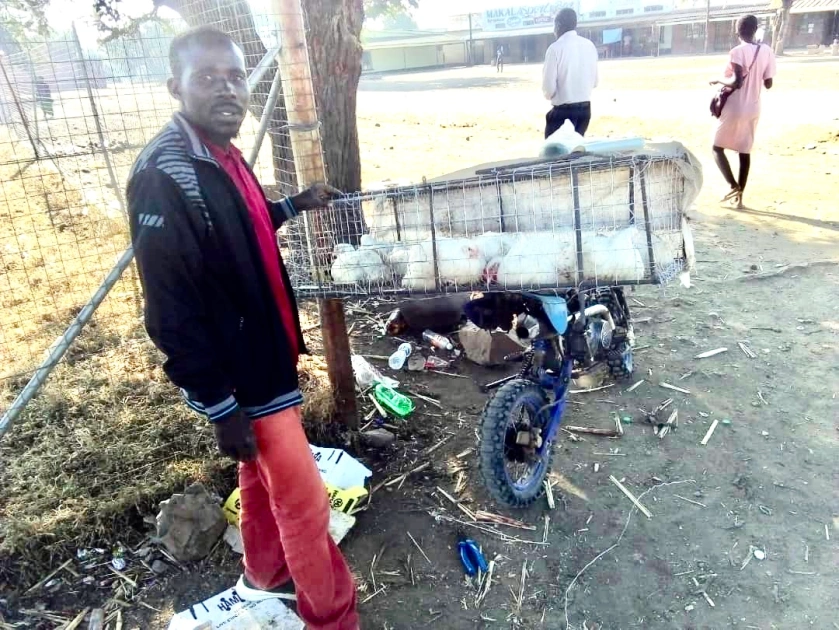In this final blog in our series on the ‘hidden middle’ around poultry production, we offer a few cases from across our sites. They are categorised according to the typology presented in the first blog in this short series. They of course don’t neatly fit, and there are inevitable overlaps, but it shows how each case engages with diverse markets, as well as vendors, suppliers, transporters, financiers and others in different ways.
All these businesses are run by women, and all are accumulating from the businesses. But these are not isolated enterprises as all are connected to other family enterprises and sources of income from employment, both on and off farm. Some are connected to global networks of diaspora financing.
Unlike the big corporate large-scale operations, these are all relatively small scale, but if you add them up over many businesses across many areas, this is a major contribution to overall poultry production in the country.
That these businesses are not really thought about, beyond support from a few NGO projects and businesses, means such initiatives are missed in wider thinking about agricultural investment and support.
They remain hidden from view, but if you go and try and buy a chicken anywhere in Zimbabwe or have chicken in a small restaurant, it is very likely that you are going to engage with these hidden markets – which, when you think about it, are actually very visible.
The contract outgrower
The contracting project in Matobo links production with marketing and extension support as part of an integrated operation run by members of a family who have a large farm and several business, as well as hosting a popular church. Social networks and trust are essential in the arrangement, but it provides good income for those involved.
My name is WS and I am 66 years old, and I live together with my husband who is now 74 in Matobo district. Back in 2000, I started with ostrich production supported by the Cunninghams, but it was difficult so I switched to broilers under contract around 2010. My broiler batches have been ranging from 1000-3000 birds every 6 weeks.
I earn about US$300 profit per batch, selling to the Hamara, the contractor market. Currently I have 1500 birds that are 6 weeks old and awaiting offtake. Hamara will come soon and ferry the birds for slaughter. They are bought at US$2.50/kg. From poultry keeping, I have made good profit and have renovated our farm infrastructure.
I also benefit from poultry manure for agriculture. However, labour is a challenge. You need to stand for in the fowl run for long periods to ensure that all birds are scattered in a uniform manner and are eating. Once upon a time my labourer failed to do this and l ran loss. Bedding material is also a scarce commodity, and limited bedding leads to soiled feet and a reduced grade of birds.
Watering from two weeks of age means you have to have a constant supply as my birds consume more than 200 litres each time I refill the tank. Since I don’t have dogs, theft is also a challenge, but I am now breeding shepherd dogs and things will improve.
Diseases can be a big problem too, as they can be affected by fowl pox caused by mosquito bites, bird flu and they can lose appetite due to poor conditions leading to poor growth. That said, you are never short of protein and poultry give a good income for investing in the farm.
The commercial supplier
Some poultry producers in our land reform sites are upgrading, as they have managed to secure guaranteed markets. In this case, via a husband who works in an army barracks. This means that broiler batches will have guaranteed sales, with no delays and extra costs.
I am Mrs Z and we have a land reform farm at Wondedzo, where I have a broiler project. I am a teacher by profession and my husband works in the army and is posted at the Fourth Brigade barracks nearby. I have kept broilers since 2009, when I started with 50. I now aim for 100 per batch, which are sold at 6 weeks ideally.
If I have not sold by 7 weeks, I do cold dressed sales. The connection to the barracks is important for my poultry project as I have a guaranteed market, selling 20-40 birds per month, about 40% of my batch.
I sell at US$6 live or US$7 cold dressed. I also sell a further 30% to local nursery schools and 20% to teacher groups and the rest to passers-by. I don’t have problems with payment defaulters as I always screen my customers. We have to have a good relationship otherwise business is problematic. I buy all my chicks, feeds and medicines from Masvingo town from various suppliers.
I now employ one worker who gets US$60 per month plus food and accommodation at the farm. He oversees all the day-to-day operations. I have managed to send two kids to boarding school with the profits from my poultry business. We always have food in the home, given my husband’s job, my poultry project and farming.
We are hoping to invest some of the money into a horticulture project and are planning to sink a borehole. We will use manure from the broilers to improve vegetable production. We will also increase batches up to 500 as long as we have a secure market that will buy at 6 weeks or less. Discussions are underway with a potential contractor for this business expansion.
The integrated operator
Many poultry producers are increasingly focusing on indigenous breeds (either improved or so-called roadrunners). These have lower costs for feed and medicine, and on-farm production can provide sufficient without bought-in feeds. Linking to guaranteed markets so the production system is integrated is essential. In the first case, the presence of artisanal miners in the area and in the second case, a network of vendors working in a local growth point.
I am Mrs ML, mother of three kids. I am 40 years old and have a self-contained land reform plot in Wondedzo together with my family. I grow indigenous fowls (improved breeds, Saso and Bushveld) and turkeys in addition to farming. The poultry all run free range and we use home-grown feed, crushing and mixing maize and sunflower. We raise the chicks in cardboard boxes and then transfer them to a pit for several weeks where they can be fed and managed carefully.
After 8 weeks they are ready to live freely on the farm. Most of the maize feed is grown on our farm, but when we need more we barter with thatching grass as there is plenty on our farm. I buy medicines and insecticides for the chickens from Masvingo town or from vendors who come and sell groceries in the rural areas, sometimes bartering with maize from the farm. We also use traditional treatments, such as aloe. Demand for indigenous chickens and turkeys is high.
I sell locally to civil servants, artisanal miners, and local consumers at the business centre. The artisanal miner market is lucrative and I sell about 30% of my chickens to them, with a road runner going for US$5, while a male turkey can sell for US$25. From the money I get, I am managing to send all kids to school. I also buy groceries and pay council levies. I am planning to increase the number of indigenous improved breeds as they are multipurpose and grow fast.
I am aiming to raise money to increase to a batch of 300 by the end of this year. We are planning to grow more sunflower and maize on the farm to cater for feed, but we are going to abandon turkeys as they cause problems with neighbours as they move around.
I am Mrs EC and I live on my farm near Chikombedzi. I have a broiler project with around 150-200 each time. My main market is vendors and small restaurants in the township of Chikombedzi. Luckily my husband works there and so I can take the chickens there for sale. I also sell at the huge Bacosi markets that are held nearby. Hundreds of people come and they need food, so I sell to those cooking there.
On a good day between the township and the market I can sell maybe 30 to 40 birds. All my birds are produced on the farm, where we grow feed. I have to supplement this with feed that is bought, but it reduces costs a lot. During the pandemic it was tough, as the vendors could not work and the markets were closed.
During that time, I had to make a plan and I ended up exchanging chickens for grain. One bird for two buckets. I accumulated a lot and bought a beast. We would distribute the chickens to those who needed them at night using our own transport to avoid the police. It’s much better now and I am making a good profit, which allows me to send kids to school and buy school uniforms.
The specialist producer
Specialising in egg production or particular types of poultry – including turkeys etc. – can give better returns. In this case, household circumstances encouraged innovation. Reducing costs through connections with local farmers who can provide feed is essential for the business.
I am CJ, married with 3 kids and one grandson and have a resettlement farm near Chatsworth. I got into poultry production during the COVID times. My husband was given leave with only half salary and we had to earn money with school fees.
I specialised on layers, as it was more profitable than broiler production. According to my calculations one layer eats 5kg of mash grower from 9-18 weeks, so I need ten 50kg bags during this period. I started with 150 birds but now l have 100. The Isa Brown variety can lay up to 300-350 eggs per year, almost one a day.
I learned that these type of birds start laying earlier than most other breeds a good Isa Brown birds can start laying as soon as 16 weeks. Most can produce eggs for 3-4 years, although the level of egg production, egg size and shell quality decreases each year. Personally, I only keep them for two years. In terms of marketing, I don’t have any problem as people in my locality are my best clients.
I have the advantage of surrounding farmers who grow maize and sunflowers. I exchange with them so as to make my own feed formulation with the help of Agritex and an NGO project, Inclusive Poultry Value Chain. Those involved in the project have a WhatsApp group so we kept in touch, even during the pandemic. I also have a garden where I get green matter for my birds. The work is not too labour intensive, so my young daughter can feed the birds without any problem and also pick eggs. I am aiming to expand my project to venture into more Roadrunners, turkeys and broilers, financed by my layers. My family has improved a lot, with my two children learning at Rufaro boarding school from the proceeds of my business.
The new investor
For the new investors, broilers seem attractive, but with the cost of feed, medicine and so on, profits can be small. As someone commented on the Twitter in response to an earlier blog, reinvesting capital in sustaining a poultry business is essential. This is why diversification into other lines of poultry production as in the first case or branching out to new markets via diaspora connections, as in the second and third cases, can be important responses.
I am FS, a mother of five and originally from Zaka. I now have a self-contained plot in Wondedzo where I have run a broiler project since 2007.
This is my project, and other family members are responsible for cropping and livestock production. I started with 25 day-old chicks, but I aim to have about 100 these days. I sell a batch every four weeks, mostly locally. I have regular sales arrangements with civil servants, local food outlets, artisanal miners and some businesses. Others are sold one, one to passers-by and local villagers. I look forward to agricultural shows and field days as I can sell my birds. I also sell to vendors whom I trust in town who then pay me after a day’s sales. I get my day-olds from Masvingo town. I come on the bus from town to the local shops and then transport the chicks and any feed I buy to my home by ox-drawn scotch cart.
When I am short of feed, I can call agents who come with feed, but this is expensive. Feed costs are skyrocketing, with each 50kg bag costing US$35. With 100 birds I may need 14 bags per batch, which is too much! If I have 5% mortality and then the family takes some each month, I may only sell 85 birds at an average of US$6. This means profit is slim, even if I sell all on time. If I have to keep them because the market is down, then I must buy more feed. I am thinking of scaling down broilers and go for improved indigenous breeds that cost less to produce, as I will use home-produced feed from the farm. They are also dual purpose, both for meat and eggs. I have already made an order for the Saso breed
I started the project in 2018 at the A1 farm in Vimbi in Matobo. I continued until 2020 but stopped in 2021 because of my father-in-law’s illness, and then resumed in 2022. I run 100 chickens at a time, and this is my second batch this year. I used to sell the chickens at Savemore supermarket in Maphisa and Green groceries in Kezi, but recently Savemore are rearing their own chickens.
So I sold the last batch in Bulawayo. My daughter who is in diaspora helped me to sell the chickens. She has many friends in Australia. These friends buys the chickens for their families who live in Bulawayo. Last time, one of my daughter’s friends ordered as many as 15 chickens at once.
I slaughter and deliver the chickens in Bulawayo, and my daughter collects the cash and send to me via Mukuru or Western Union. Sometimes, my other daughter who lives in Bulawayo and is a member of the World of Life church sells the chickens for us to her church mates. Some time ago, my husband took the chickens in a lorry and sold them to gold panners in Maphisa. I sell each bird for US$7 locally or R120.
I am Mrs TN, and we have a self-contained farm in Matobo and a house in Bulawayo, where I’ve running my broiler project. In most cases, I run six batches of broilers every year. Currently, I have a batch of 200 broilers and 50 road runners. I sell the chickens at my workplace (at Lobengula high school).
I also sell the chickens to people working in the industries in Kelvin North as well as small indigenous canteens. I sometimes get orders to supply 50 birds of broiler chickens at weddings. I also have a younger sister who is living and working in Canada. She also markets my broilers for me. She gets customers for me in Canada, Zimbabweans who also live in Canada, but having parents in Zimbabwe.
So, those people buy the chickens from my sister in Canada for their parents who are living in Bulawayo. My sister receives the cash in ‘real’ US dollars in Canada, and I will then deliver the chickens to their parents in Bulawayo. I slaughter the chickens and dress them myself. It’s really a good business especially in December. Sometimes I will be having at least five parents that I deliver to. In most cases, I deliver between 10–15 birds per family.
My sister will then send the money through Western Union. I receive the money in US dollars. I will then sell the US dollars at a black market and get more money. When we slaughter the chickens, we also pack intestines and chicken feet in small packets and sell to the less privileged for a US$1 per packet. So, we do not throw away anything.
*****
These cases offer a glimpse into the varied operations of female small-scale poultry producers operating across our land reform sites. As an additional source of income, and very much integrated into farming operations, poultry production is booming. It is not without challenges, but as people learn about production, feed supply, veterinary care and marketing, many are making a decent profit.
With small-scale production of eggs and poultry meat now higher than the large-scale industrial operations, the array of linked enterprises that support these many small operations are an important part of the ‘hidden middle’ of the new post-land reform rural economic landscape.
Thanks to Felix Murimbarimba and the team in Mvurwi, Matobo, Chikombedzi, Triangle, Masvingo and Gutu for contributions to this blog. Special thanks too to Tapiwa Chatikobo who supplied extra case studies from Matobo, covering the important dynamic of diaspora payments.
This blog was written by Ian Scoones and first appeared on Zimbabweland
Source ZimSituation












